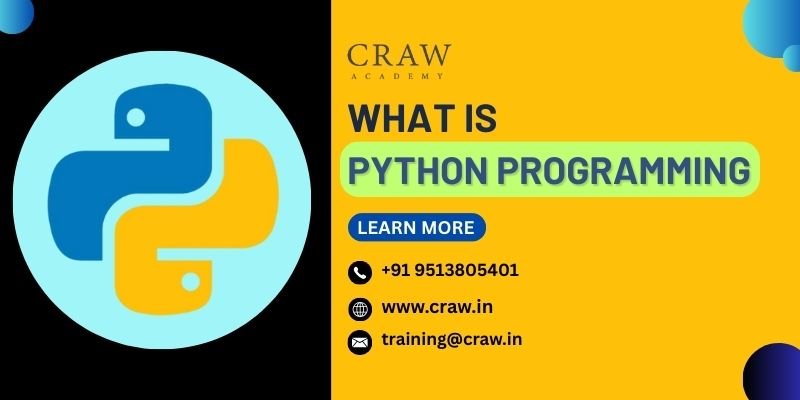Python programming is a high-level, interpreted language known for its simplicity and readability. In the last ten years, Python has changed from a general-purpose scripting language to a leading force in software development. From web applications to machine learning, from automation to cybersecurity, Python’s versatility is unmatched. But what truly makes Python stand out in a crowded field of languages like C++, Java, and SQL?
In this guide, you will learn about Python’s history, main features, real-world uses, and benefits over other languages. You will also find out how to start your Python journey effectively.
The Origins of Python
Python was created in the late 1980s by Guido van Rossum and was officially released in 1991. The goal was to create a language that focused on code readability. It aimed for a clean syntax. This would let developers express ideas in fewer lines of code than languages like C or Java. Van Rossum’s vision has come true in ways we never expected. Today, Python is one of the most popular programming languages in the world.
Why Python Stands Out Among Other Programming Languages
1. “Batteries Included” Philosophy
Python’s strength lies in its rich standard library. It comes with built-in modules for file I/O, web services, data manipulation, and internet protocols. This makes Python incredibly useful right out of the box, especially for beginners.
2. Clean and Simple Syntax
Python syntax is designed to be intuitive and close to natural language. This makes it ideal for newcomers and dramatically reduces the time required for development and debugging.
3. A Vast and Supportive Community
Python has one of the largest programming communities in the world. Many resources are available to help you learn and solve problems faster. Whether you are a new or experienced developer, you can find tutorials, forums, libraries, and frameworks.
Applications of Python in the Real World
Python’s versatility is reflected in the wide range of industries and domains it serves:
1. Web Development
Python powers dynamic websites and APIs through frameworks like Django and Flask. These frameworks make it easier to work with databases, process forms, and route URLs. This helps you build secure and scalable web applications faster.
Popular Use Cases:
-
Instagram uses Django for its backend.
-
Reddit was originally written in Lisp but later migrated to Python.
2. Data Science and Machine Learning
Python is the go-to language for data scientists and AI researchers. Libraries like Pandas, NumPy, Matplotlib, TensorFlow, and PyTorch are useful tools. They help users clean data. They also allow users to see trends and train machine learning models.
Popular Use Cases:
-
Predictive analytics in healthcare.
-
AI-powered recommendation systems in e-commerce.
3. Automation and Scripting
Python excels at automating repetitive tasks. Python scripts can quickly handle many tasks. They can rename thousands of files, scrape websites, send automated emails, and manage cloud infrastructure.
Example Tools:
-
BeautifulSoup for web scraping.
-
Selenium for browser automation.
4. Game Development
C++ is the top choice for AAA game development. However, Python is great for making simple 2D games and educational tools. Libraries like Pygame make it easy to use.
5. Cybersecurity and Ethical Hacking
Python’s flexibility allows cybersecurity professionals to write custom tools for scanning networks, automating penetration tests, and detecting vulnerabilities.
Key Libraries and Tools:
-
Scapy (network packet manipulation)
-
Metasploit (integrates Python scripts)
Benefits of Learning Python
1. High Demand Across Industries
Python skills are in demand in technology, finance, healthcare, government, and even agriculture. Roles like data analyst, backend developer, and DevOps engineer frequently list Python as a core requirement.
Many job platforms and developer surveys indicate that Python is among the top three programming languages for job opportunities. This is true worldwide.
2. Portability and Cross-Platform Support
Python runs seamlessly on Windows, macOS, and Linux. It’s also used in microcontroller environments like Raspberry Pi through MicroPython.
3. Perfect for Both Beginners and Experts
Python lowers the barrier to entry for new programmers with its readable syntax. At the same time, it is powerful enough for advanced tasks like natural language processing and neural networks.
4. Large Ecosystem of Tools and Libraries
From scientific computing to blockchain development, Python has a library for almost everything. Its integration with APIs, databases, cloud platforms, and IoT devices further extends its capabilities.

Real-World Python Projects
Python is behind some of the world’s most influential tech platforms and applications:
-
Google uses Python extensively for internal tools.
-
Netflix: Manages backend services and data pipelines.
-
NASA: Processes and visualizes space data.
-
Spotify: Uses Python for data analysis and recommendations.
-
Instagram: Relies on Django, a Python framework, for scalability.
Other popular project ideas for learners include:
-
Chatbots with NLTK or spaCy.
-
Data dashboards using Plotly, Dash, or Streamlit.
-
IoT projects using Raspberry Pi.
-
Web scraping tools to gather competitive intelligence.
How to Start Learning Python
Step-by-Step Roadmap:
-
Choose an IDE: Start with VS Code, PyCharm, or Jupyter Notebook.
-
Beginner Tutorials: Explore beginner-friendly tutorials on CrawSecurity, Coursera, or YouTube.
-
Practice Projects: Start small—like a to-do app, calculator, or web scraper.
-
Join the Community: Engage in forums like Stack Overflow, Reddit, and GitHub.
Frequently Asked Questions
Q1: What is Python programming?
Python programming means writing code in the Python language. This code can do many tasks, such as data analysis, web development, and automation.
Q2: Can I learn Python in 7 days?
You can grasp the basics—variables, loops, functions—in 7 days. Full mastery requires longer practice and real-world experience.
Q3: What is Python used for?
Python is used in:
-
Web development
-
Data science
-
Automation
-
Game development
-
IoT and cybersecurity
Q4: Is Python better than C++?
Python is better for productivity and simplicity. C++ is better for performance-critical tasks.
Q5: Where is Python used in real life?
Used by Google, Netflix, NASA, Spotify, and Instagram for a range of backend, data, and automation needs.
Q6: What is the benefit of Python?
It’s readable, beginner-friendly, widely supported, and has extensive libraries.
Q7: Is Python easy to learn?
Yes, thanks to its simple syntax and rich learning resources.
Q8: Which is the hardest programming language?
C++, Assembly, Haskell, and Rust are among the toughest due to complexity.
Q9: Which is better, Java or Python?
Python for flexibility and fast prototyping. Java for enterprise systems and Android apps.
Q10: How to start learning Python?
Install Python → Use VS Code or PyCharm → Take beginner tutorials → Build small projects → Explore platforms like CrawSecurity.
Q11: Is SQL easier than Python?
Yes, initially. But Python offers broader capabilities beyond databases.
Q12: Which coding is tough?
Languages like C++, Haskell, and Assembly are harder due to syntax and abstraction.
Q13: How many days to learn Python?
Basic comfort in 30 days with regular practice. Mastery depends on depth and application.
Q14: What is the full form of SQL?
Structured Query Language.
Q15: Is Python important for cybersecurity?
Yes. It’s used for writing security tools, automating scans, and analyzing threats.
Conclusion
Python has earned its reputation as the “Swiss Army knife” of programming languages. Its blend of simplicity, power, and broad applicability makes it ideal for both newcomers and professionals.
Python helps you with many things. You can automate simple tasks. You can create smart systems. You can also explore cybersecurity. Python has the tools and support you need to succeed. With a growing ecosystem and rising demand in many industries, now is a great time to start your Python journey.












































